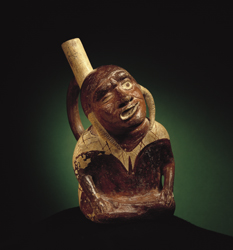Stirrup spout vessel
Stirrup spout vessel refers to a distinctive type of ceramic container that emerged in ancient Pre-Columbian civilizations of South America, particularly within the cultures of the Central Andes. Characterized by its unique spout structure, which resembles a stirrup, these vessels are an important artifact in the study of Andean archaeology and Pre-Columbian art.
Description[edit | edit source]
A stirrup spout vessel is made up of a hollow, spherical, or sometimes cylindrical body, with a single spout that branches off into two arms before joining again to form a loop, resembling the shape of a horse's stirrup. The spout is often connected to the body of the vessel by a bridge or a narrow neck. This design is not only aesthetically pleasing but also functional, as it allows for a more controlled pour and reduces the chance of spillage. The vessels were primarily used for holding liquids, including water, chicha (a type of fermented beverage), and possibly oils.
Cultural Significance[edit | edit source]
Stirrup spout vessels are most closely associated with the Moche civilization (1-800 AD), although they were also produced by other cultures such as the Nazca, Chimú, and Chavín. These vessels often feature highly detailed and complex iconography, including images of gods, animals, and scenes of daily life and ritual. As such, they are considered a key source of information on the religious beliefs, social structures, and practices of these ancient societies.
Manufacturing Techniques[edit | edit source]
The creation of stirrup spout vessels required significant skill. Artisans used a combination of coiling and molding techniques to form the body and spout. The vessels were then decorated using slips of various colors before being fired in kilns. The precise methods of decoration and firing varied between cultures, contributing to the distinct styles seen in vessels from different regions and periods.
Archaeological Significance[edit | edit source]
Stirrup spout vessels are valuable to archaeologists for several reasons. Firstly, their widespread use and distinct styles help in the dating and cultural attribution of archaeological sites. Secondly, the iconography on these vessels provides insights into the mythology, rituals, and social practices of the cultures that produced them. Finally, analysis of residue inside the vessels can offer information on the diet and trade practices of these ancient peoples.
Preservation and Display[edit | edit source]
Many stirrup spout vessels have been preserved in museums and private collections around the world. Efforts to conserve these artifacts involve careful cleaning, restoration, and sometimes reconstruction of damaged pieces. These vessels are displayed in museums as examples of Pre-Columbian art and are studied by scholars interested in the ancient cultures of South America.
Search WikiMD
Ad.Tired of being Overweight? Try W8MD's physician weight loss program.
Semaglutide (Ozempic / Wegovy and Tirzepatide (Mounjaro / Zepbound) available.
Advertise on WikiMD
|
WikiMD's Wellness Encyclopedia |
| Let Food Be Thy Medicine Medicine Thy Food - Hippocrates |
Translate this page: - East Asian
中文,
日本,
한국어,
South Asian
हिन्दी,
தமிழ்,
తెలుగు,
Urdu,
ಕನ್ನಡ,
Southeast Asian
Indonesian,
Vietnamese,
Thai,
မြန်မာဘာသာ,
বাংলা
European
español,
Deutsch,
français,
Greek,
português do Brasil,
polski,
română,
русский,
Nederlands,
norsk,
svenska,
suomi,
Italian
Middle Eastern & African
عربى,
Turkish,
Persian,
Hebrew,
Afrikaans,
isiZulu,
Kiswahili,
Other
Bulgarian,
Hungarian,
Czech,
Swedish,
മലയാളം,
मराठी,
ਪੰਜਾਬੀ,
ગુજરાતી,
Portuguese,
Ukrainian
Medical Disclaimer: WikiMD is not a substitute for professional medical advice. The information on WikiMD is provided as an information resource only, may be incorrect, outdated or misleading, and is not to be used or relied on for any diagnostic or treatment purposes. Please consult your health care provider before making any healthcare decisions or for guidance about a specific medical condition. WikiMD expressly disclaims responsibility, and shall have no liability, for any damages, loss, injury, or liability whatsoever suffered as a result of your reliance on the information contained in this site. By visiting this site you agree to the foregoing terms and conditions, which may from time to time be changed or supplemented by WikiMD. If you do not agree to the foregoing terms and conditions, you should not enter or use this site. See full disclaimer.
Credits:Most images are courtesy of Wikimedia commons, and templates, categories Wikipedia, licensed under CC BY SA or similar.
Contributors: Prab R. Tumpati, MD

